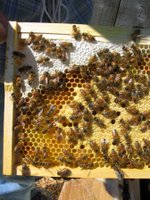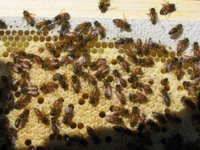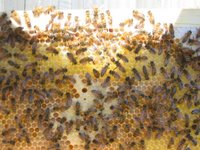First Hive Inspection!
In the past week, we have participated in silent negotiations with our bees concerning water. We had already filled a shallow container, added pebbles (so they won't drown), and placed it near their hives. We saw no visitors. We moved it nearer. Nothing. But we noticed bees looking close to the house, circling around the water hose faucet. This happens to be a high foot traffic area for humans and dogs.....yet there is a small flower bed closeby, and we placed the water here as a compromise. They immediately began foraging the water! For our part, we keep the water fresh and easily available, and siphon off any excess so bees don't drown. Also, they've chosen to forage water from the bird bath in our front yard, and that's perfectly fine too.
Our first inspection day was sunny, 75 degrees, and we visited about 10:30 am. We both decided to work bare-handed....the smoker puffed steadily, and we had another good experience. In hive 1, we removed a frame near the center, and were able to see the tiny eggs that look like rice, capped and uncapped brood, and active bees--evidence our queen is alive and productive. We only removed a few frames for viewing, and observed they have filled 6-7 (out of 10) frames in this top super already! Should we add a third super soon? The frames felt weighty, and the bees were docile with us, only mildly disturbed.
In the second hive, we observed only 4-5 of the top frames were filled. However, we saw the rice-like eggs, capped and uncapped brood....so this queen is alive and working too, thank goodness. We saw what we assumed was pollen, though a few spots were dark red....we immediately thought, "Blood!" (too much dramatic tv?) We didn't feel sure of what we were seeing....is the brood too watery? Is the red color a sign of disease? Is everything okay? Fortunately, we remembered we had brought the digital camera out with us, and took several photos. This is what we saw:


We actually didn't spend a lot of time in either hive...just enough to check a few frames and leave them to their work. Once inside our house, we were elated--the queens are alive!! There is brood we can see! We both worked bare-handed, and received no stings! Even the smoker worked! You know what? It was a RUSH, plain and simple. We downloaded the photos and realized how important this was: to be able to sit down and take all the time in the world to examine the frames and everything on them, even get close-ups! We scanned all the disease descriptions in the bee books, and thankfully found no similiarities in our hives. We sent our photos to our mentor Ron (who sent them to another beekeeping friend), and an expert in our state.
- Ron gave us a thumbs up, and suggested the red we saw is pollen from the maple trees.
- Ron's friend said the brood pattern looks good (meaning a productive queen who uses space efficiently). She suggested not adding a third super just yet--if the bees have too much room, they may not be able to cover their brood if it gets chilly. She also suggested checking the bottom super. The queen likes to move upward as she lays, and will leave supers under her empty. If this IS the case, we can simply reverse the hive bodies.
- Our bee expert said the frames look VERY normal, the brood looks healthy, and the various colors are indeed pollen.
What a huge relief to have positive affirmation that all is well! By now, we have refilled the sugar syrup several times (especially for hive 1). An easy time for us to do this is at night, by moonlight or flashlight. We just slip the feeder out and check to make sure no bees are inside it. Of course, we've found a few bees hanging out after-hours at the Sugar Syrup Bar, completely soused! They are pretty easily brushed off. Usually, at least one brave guard bee will come onto the flight deck to check on things, but she never seems too disturbed. We clean the feeders with hot water, add fresh syrup, and slip them back into quiet hives. The jars sometimes spill a lot and tilt....we can't seem to get a feel for how they're supposed to work well. Once, the hive feeder made a solid KNOCK! against the hive, and I got a loud BUZZZ! in response. Then total silence.


0 Comments:
Post a Comment
<< Home